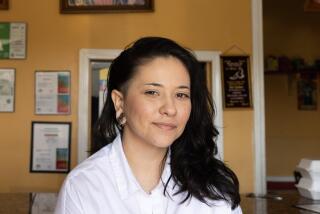Population Shifts Hit Congregation With Fatal Blow : Religion: Latino Catholics have rapidly replaced Midwestern Methodists in Cudahy, prompting the closure of the last Anglo church.
- Share via
CUDAHY — In the early 1980s, when nearly all the new businesses opening up in this city had Latino names and Spanish became the language of the streets, the congregation of the Community Church and Christian Center foresaw its fate.
Where once plenty of Midwestern Methodists had settled, new immigrants, most of them Mexican, came in droves.
From 1970 to 1980, the Latino population mushroomed from 26.7% of the total to almost 90%, and the Evangelical Methodist leaders of the church found themselves surrounded by Catholics whose language they could not speak.
“We saw it coming,” said longtime Community Church member Dick Hines. “We just didn’t want to admit it.”
Last month, the leadership of the Community Church and Christian Center, unable to build its congregation, sold the church to the Roman Catholic Archdiocese of Los Angeles.
Jim Klein, the last pastor of the Community Church and Christian Center, said there were only 15 people in the congregation when the church closed last month. The Community Church and Christian Center was the last of the Anglo churches in Cudahy.
Meanwhile, the need for a Catholic church in Cudahy today is tremendous, said Bishop Carl Fisher, an auxiliary bishop of the Archdiocese of Los Angeles, whose jurisdiction includes Cudahy.
With no Catholic churches in Cudahy or Bell, many Catholics in both cities go to Huntington Park or Bell Gardens.
“The growth of the Catholic Church in the area is just phenomenal,” Fisher said. “The existing churches are just unable to cope with the demand.”
Fisher said a new Catholic church is expected to open in the old Methodist building before the end of the year. Father Rody Gorman, pastor of St. Matthias Catholic Church in Huntington Park, said priests in the area have been pleading with the archdiocese to open a Catholic church in Cudahy for the last 10 years.
St. Matthias can accommodate about 400 people at each service, but Gorman said that there are 5,000 members and at least 5,000 non-members who attend Mass there. In order to serve all the parishioners, an astonishing 14 services must be celebrated each weekend, he said.
“We just cannot handle it,” Gorman said.
Cudahy Community Church’s experience reflected that of other churches in the area, especially where the leadership of the church was not bilingual, Gorman said. But even where leadership is bilingual, making the transition from an Anglo to a Latino congregation is difficult, he said.
“It’s tough,” he said. “Traditionally you need an Anglo congregation that will continue to support (financially) the church until such time that the Hispanics can take over.”
There was a time--when it was called the United Evangelical Methodist Church--that the church was a center of community activity in Cudahy.
Nearly 300 people packed the pews, drawn by the fiery sermons of Pastor Dale Barrett and a chance to socialize with people from around the Cudahy area.
“It was a beacon in the community,” Hines said.
From 1970 to 1977, when Barrett headed the church, a school and a home for troubled youths were built.
“In the height of the ministry, we probably ministered to 400 or 500 people,” said Barrett, who is now pastor of a church near Dallas. “I worked hundred-hour weeks. I helped people buy their cars, their houses . . . During our midweek services we probably had 200 people coming in. Most (of the members) were poor and they really had no other social alternative. They built their life around the church.”
Early attempts to bring more Latinos into the main congregation failed, and Hines admits that perhaps church leaders did not try hard enough.
By the late 1980s it was too late. Most of the Latinos moving into the area spoke no English. None of the church leaders spoke Spanish. As Latinos moved into Cudahy, longtime church members moved out and into communities like Lakewood, Lake Elsinore and Upland. Those that stayed were elderly and infirm.
The combination of demographic changes and the relocation of longtime members sounded the death knell for the church, Barrett said.
“We wanted to take people who were distressed, emotionally, physically, mentally, and help them get cleaned up,” Barrett said. “But when they got well, what would they do? Move out of the community.”
More to Read
Sign up for Essential California
The most important California stories and recommendations in your inbox every morning.
You may occasionally receive promotional content from the Los Angeles Times.













